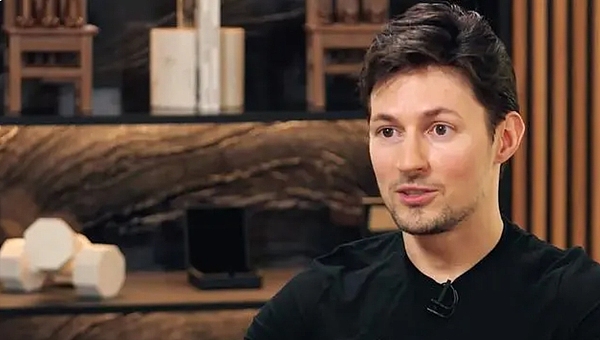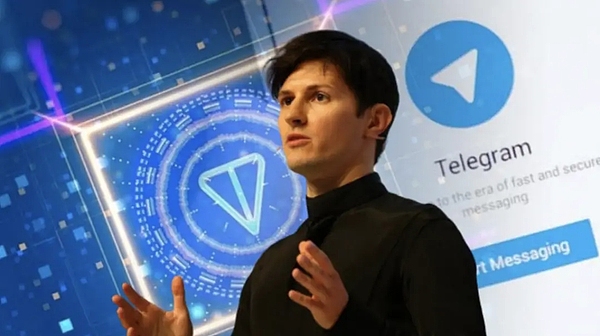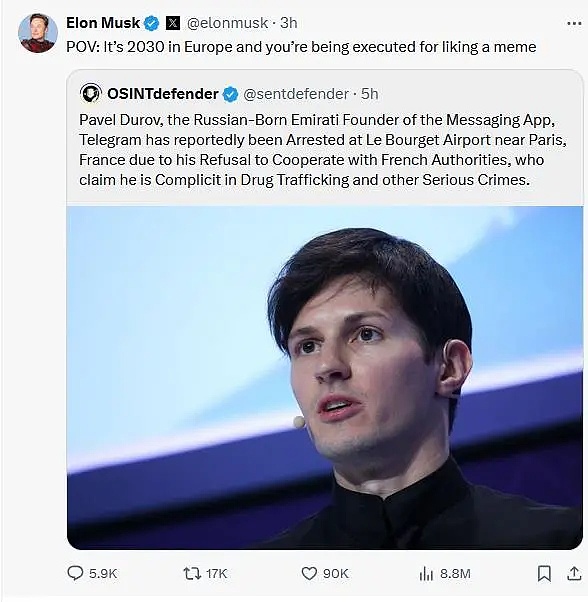Author: BlueDAO
According to French media BFMTV, on the evening of August 24, local time, 39-year-old Telegram founder Pavel Durov was arrested at Le Bourget Airport in Paris, France.

According to reports, Durov, who has multiple nationalities including Russia, France, and the United Arab Emirates, had been included in France's wanted list earlier.
French prosecutors believe that the Telegram platform has previously refused to cooperate with law enforcement agencies and lacks management, resulting in the platform being used for money laundering, drug trafficking and sharing pedophile content. Durov may be charged with a variety of crimes, including terrorism, drug trafficking, fraud, money laundering and the dissemination of child pornography. French journalist Cyril Amursky said that Durov may face up to 20 years in prison in France.
Durov was born in Russia in 1984. He is the founder of the social networking sites VKontakte and Telegram. He was the former CEO of Vkontakte. After Durov resigned as the CEO of Vkontakte in 2013, he worked with Nikolai Durov on the development of Telegram and is currently the CEO of Telegram. Durov left Russia in 2014 and has lived in the UAE most of the time. He currently holds the nationality of Russia, Saint Kitts and Nevis, France and the UAE. Forbes estimates that Durov has a fortune of $15.5 billion.

Telegram, also known as Telegram, is a well-known cross-platform instant messaging software that supports users to exchange encrypted and self-destructing messages with each other, and send all types of files such as photos and videos. Telegram can provide end-to-end encrypted messaging and is currently one of the most important social platforms used by Russian media and Russian-speaking users. It has a great influence in Russia, Ukraine and former Soviet countries and has a large number of users. In March 2024, Durov said that Telegram has 900 million users, is close to profitability, and may go public.
As for the arrest of Pavel Durov, the founder of the social media "Telegram" in France on August 24, many parties responded to it.
The deputy chairman of the Russian State Duma called for his release
According to Russia Today, after Durov was arrested, the deputy chairman of the Russian State Duma (lower house of parliament), Davankov, immediately protested and called on the French government to release Durov.
Davankov wrote on Telegram on the 25th: "Almost no one has made a greater contribution to the development of digital services in Russia and the world than him... We need to rescue him. I have urged Russian Foreign Minister Lavrov to take action and call on the French authorities to release Durov. The arrest may be politically motivated and aimed at obtaining the personal information of Telegram users. We cannot allow this to happen."
Davankov believes that "illegal activities exist on all social platforms, but no one arrests or imprisons their owners, and this should not happen." He also declared that if the French government refuses to release Durov, Russia should "make every effort" to send Durov to the UAE or Russia, "of course, the premise is that he agrees."
But according to media reports, because Pavel Durov is a French citizen, he will not be exchanged or extradited to other countries. According to reporters close to the European Parliament, the EU may impose sanctions on Telegram.
Regarding this incident, Russian Foreign Ministry spokesperson Zakharova responded on the 25th that the Russian Embassy in France has taken necessary measures and is looking into Durov's situation.
Musk commented on the arrest of Telegram founder: In 2030, you will be executed in Europe for liking an emoticon
Musk also expressed his strong dissatisfaction with the case on social media X. He posted: "It is Europe in 2030, and you are executed for liking an emoticon!"

We don't know whether there is a political conspiracy behind Durov's arrest. But he did sound the alarm for all encryption applications. For example, are crypto applications in the currency circle compliant with regulatory compliance? Where is the boundary between technology and law?
 JinseFinance
JinseFinance
 JinseFinance
JinseFinance JinseFinance
JinseFinance Dante
Dante Bernice
Bernice Others
Others Nulltx
Nulltx Nulltx
Nulltx Nulltx
Nulltx Nulltx
Nulltx Cointelegraph
Cointelegraph